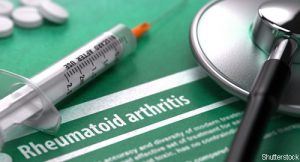 ACR CONVERGENCE 2020—Recent research findings suggest rheumatologists need to take a closer look at two gold standard autoantibodies used to diagnose seropositive rheumatoid arthritis (RA)—rheumatoid factor (RF) and anti-cyclic citrullinated peptide (anti-CCP), according to Caroline Grönwall, PhD, associate professor in the Division of Rheumatology at Karolinska Institute, Stockholm, and Miriam Shelef, MD, PhD, associate professor in the Division of Rheumatology at the University of Wisconsin-Madison School of Medicine and Public Health, where she runs a research program.
ACR CONVERGENCE 2020—Recent research findings suggest rheumatologists need to take a closer look at two gold standard autoantibodies used to diagnose seropositive rheumatoid arthritis (RA)—rheumatoid factor (RF) and anti-cyclic citrullinated peptide (anti-CCP), according to Caroline Grönwall, PhD, associate professor in the Division of Rheumatology at Karolinska Institute, Stockholm, and Miriam Shelef, MD, PhD, associate professor in the Division of Rheumatology at the University of Wisconsin-Madison School of Medicine and Public Health, where she runs a research program.
Rheumatoid factor is a measure of antibodies against IgG. Anti-CCP is a surrogate for anti-citrullinated protein antibodies. These antibodies have traditionally been used to measure autoantibody status for early identification of seropositive RA.1
During the ACR Convergence session Antibodies in RA: Beyond Citrullination & Back to Rheumatoid Factor, these investigators discussed new evidence in their respective study areas that could influence how RA antibodies are assessed and used for diagnostics and understanding preclinical RA development.
Present & New Roles for Autoreactivity to Citrullination
Dr. Grönwall leads a research team investigating how autoantibodies and autoreactive B cells contribute to the pathogenesis of human diseases like RA.
RA is associated with antibodies to anti-citrullinated proteins, commonly known as ACPAs. Citrullination happens when a post-translational modification of the amino acid arginine to citrulline occurs. Dr. Grönwall began by discussing what is known about this autoreactivity.
ACPAs are routinely detected with a cyclic citrullinated peptide (CCP) test. Yet, peptide screenings show that each patient may have different ACPA-fine specificities (i.e., may have a particular pattern of ACPA targeting different citrullinated antigens). A range of autoantigens has been investigated—some of the favorites include citrullinated fibrinogen, vimentin, alpha-enolase, histones and collagen type II. Dr. Grönwall showed what autoreactivity profiles look like in a cohort of RA patients to demonstrate that RA patients can have their own unique profiles of ACPA-fine specificities, but pointed out glycines in many of these peptides, either in the plus one position compared with citrulline or in the minus one position.
Besides using serology and polyclonal antibodies to address autoreactivity, the Karolinska Institute research team has in collaborative efforts, used an approach working with monoclonal antibodies from single B cells in RA patients from a variety of sources, including synovial fluid, lung tissue, gingiva tissue and bone marrow, and identified approximately 30 different monoclonal ACPAs that are CCP-reactive. Methods are described in an online protocol and some monoclonal antibodies [mAbs] have been published by Steen et al. and Titcombe et al.; others are in progress.2,3,4 These monoclonal antibodies each bind to several different citrullinated peptides and are multi-reactive.
“This is not really what we are expecting when we are working with affinity mature B cells; we are expecting the reactivity to narrow down to single reactivity,” Dr. Grönwall said.
In a different approach using a large array with over 50,000 peptides, Dr. Grönwall said the extent of this multi-reactivity can be seen with binding to hundreds and even thousands of peptides. “We do find some of our usual suspects, such as filaggrin and collagen type II, but we also see a lot of other antigens targeted by the different monoclonal antibodies. This works by way of the ACPAs recognizing very small, linear, citrullinated-epitopes (binding motifs), as demonstrated by Sahlström et al., some including glycines, and with variations in the mAbs’ binding preferences,” she explained.5
The takeaway from these findings is that the antibodies bind to very small binding motifs, and all have unique signatures in what they bind to.
Emerging evidence from Dr. Grönwall’s lab and others shows citrullinated protein is one of several post-translational modifications targeted by multi-reactive autoantibodies in RA. For example, when using an array similar to the citrulline array, with almost 50,000 peptides that are now carbamylated peptides, a number of monoclonal antibodies have multi-reactivity to carbamylated and acetylated peptides. She stressed that the term multi-reactivity is preferred to cross-reactivity, because “cross-reactivity makes you think that the citrulline is the strongest reactivity, but this is not necessarily always the case.” For example, in a competition experiment conducted in Dr. Grönwall’s lab, the highest affinity for the monoclonal antibody is to acetylated peptides.
Given this multi-reactivity with clones reactive beyond citrullination, Dr. Grönwall said the term anti-modified protein autoantibodies is being used to demonstrate multi-reactivity beyond citrulline-only reactive ACPAs.
She also noted that different ACPA clones have different pathogenic functionality. For example, research by Sun et al. showed that some clones have the ability to mediate fibroblast migration and other clones have the ability to increase osteoclastogenesis.6
“We see these different clones have different reactivity patterns. We think this is important, but so far we don’t know exactly what the targets are and what is defining to have one functionality or another,” Dr. Grönwall said.
Moving back to serology and looking at reactivity in RA patients, unpublished research from Dr. Grönwall’s lab showed higher reactivity toward carbamylation and acylation, particularly in CCP-positive patients. Also, overlap occurs between these reactivities, with carbamylation reactivity primarily seen within the citrulline reactivity, and acetylation reactivity largely seen in patients who have both citrullination and carbamylation reactivity. “We can also see that the carbamylation and acylation activity is primarily seen in RA patients with very high citrullination reactivity, so there seems to be a correlation there,” she noted.
Several peculiar properties of ACPAs have been discovered, including fab-glycosylation in the variable region of the antibody. “We do not think these have a very strong effect on the binding to the antigens, but instead they may have important roles in the B cell activation and selection,” Dr. Grönwall said. Another peculiar property of ACPAs is that there can be IgG4 in ACPA responses, which may be a sign of chronic B cell responses, so “in ACPA-positive RA patients, there is something more to understand about the B cell responses and B cell repertories that is very interesting.”
In concluding her portion of the session, Dr. Grönwall said a key question to explore further is whether citrullination is a special modification targeted by RA autoantibodies or perhaps is simply the first to be characterized.
Dr. Grönwall stressed that ACPAs are multi-reactive to different citrullinated proteins beyond “classical” antigens, by recognition of small epitopes, and “we have a lot to learn there.” However, each B cell clone has a unique multi-reactivity pattern and different clones have different functionalities, she added. Also, because some citrulline-reactive clones bind to carbamylated and acetylated epitopes, this may explain why carbamylation and acetylation reactivity is seen in serology studies.
Dr. Grönwall said these combined findings demonstrate implications for understanding autoreactive B cell biology and also for understanding the autoreactivity profiles in different RA patients and different subsets of RA patients. “It will be interesting to continue to investigate the clinical and pathological importance of this multi-reactivity in the future.”
A deeper understanding of citrullination & rheumatoid factor activity, & how they overlap in RA, is showing new possibilities for developing diagnostics & gaining insights into pathophysiology.
Evaluating Rheumatoid Factor in RA
In the second portion of the session, Dr. Shelef outlined recent research that addresses the timing and mechanisms of RF in the development in RA. For example, understanding the risk factors for RF versus ACPAs for RA is growing. “This has been hard to tease out because RF and ACPA tend to coexist, but it’s looking like smoking is the main driver of RF, whereas for ACPAs the shared epitope may be the main driver,” she explained.
“It’s thought that MHC [major histocompatibility complex] molecules with the shared epitope, which is a sequence present in multiple different RA-associated MHC molecules, seem to bind better to citrullinated peptides, but additionally there is some evidence that those MHC molecules can bind better to peptidylarginine deiminases 4 peptides, leading to ACPAs, in more of a hapten-carrier model.”7,8
She said smoking is also a risk factor for ACPAs, but only if the shared epitope is present.
Dr. Shelef went on to explain several ways that RF is different in RA vs. non-RA, including binding sites, isotypes bound, RF isotypes, affinity maturation, as well as IgG-reactive T cells that are uniquely present in RA.
“There are several reasons why we care about these differences,” Dr. Shelef shared. The first is for diagnostic opportunities, if RF binds to different sites in RA but not in non-RA. As an example, she highlighted a 2020 study by Falkenburg et al. showing an engineered IgG has increased binding in RA versus Sjögren’s syndrome, and findings like this can be developed further for better diagnostics.9
Differences between RF in RA and non-RA can also provide pathophysiologic insights, which Dr. Shelef and her colleagues have explored by asking if IgG-RF could develop due to loss of tolerance against citrullinated IgG.10 To investigate, they evaluated all of the different linear epitopes of IgG that could be bound by IgG in RA using a peptide array.
They found that IgG binds to citrulline-containing linear IgG peptides in seropositive RA, which signals a partial epitope overlap between RF and ACPAs, she explained. “Now we are seeing an IgG that binds to citrulline containing IgG peptides, so this antibody could be considered an ACPA because it’s binding to citrulline. It could be considered RF because it’s binding to IgG. So we have this entity that is now maybe in the middle, which leaves many questions remaining. For example, could some of these ACPAs bind the citrulline-containing peptides or maybe even citrullinated IgG? Possibly, and that is something we are investigating.”
Dr. Shelef concluded that even though an understanding of RF and its intersection with ACPAs is growing, questions clearly remain, and further research is needed to define the functional roles of RF in vaccination, infection and RA.
Carina Stanton is a freelance science journalist based in Denver.
References
- Aletaha D, Neogi T, Silman AJ, et al. Rheumatoid arthritis classification criteria: An American College of Rheumatology/European League Against Rheumatism collaborative initiative. Ann Rheum Dis.2010 Sep;69(9):1580–1588.
- Amara K, Israelsson L, Stålesen R, et al. A refined protocol for identifying citrulline-specific monoclonal antibodies from single human B cells from rheumatoid arthritis patient material.Bio-protocol. 2019 Sep 5;9(17):e3347.
- Steen J, Forsström B, Sahlström P, et al. Recognition of amino acid motifs, rather than specific proteins, by human plasma cell-derived monoclonal antibodies to posttranslationally modified proteins in rheumatoid arthritis. Arthritis Rheumatol. 2019 Feb 7;71(2):196–209.
- Titcombe PJ, Wigerblad G, Sippl N, et al. Pathogenic citrulline-multispecific B cell receptor clades in rheumatoid arthritis. Arthritis Rheumatol. 2018 Dec;70(12):1933–1945.
- SahlströmP, Hansson M, Steen J, et al. Different hierarchies of anti–modified protein autoantibody reactivities in rheumatoid arthritis. Arthritis Rheumatol. 2020 Oct;72(10):1643–1657.
- Sun M, Rethi B, Krishnamurthy A, et al. Anticitrullinated protein antibodies facilitate migration of synovial tissue-derived fibroblasts. Ann Rheum Dis. 2019 Dec;78(12):1621–1631.
- Auger I, Balandraud N, Massy E, et al. Peptidylarginine deiminase autoimmunity and the development of anti-citrullinated protein antibody in rheumatoid arthritis: The hapten-carrier model. Arthritis Rheumatol. 2020 Jun;72(6):903–911.
- Scally SW, Petersen J, Law SC, et al. A molecular basis for the association of the HLA-DRB1 locus, citrullination, and rheumatoid arthritis. J Exp Med. 2013 Jun;210(12):2569–2582.
- Falkenburg WJJ, Oskam N, Koers J, et al. Identification of clinically and pathophysiologically relevant rheumatoid factor epitopes by engineered IgG targets. Arthritis Rheumatol. 2020 Dec;72(12):2005–2016.
- Zheng Z, Mergaert AM, Fahmy LM, et al. Disordered antigens and epitope overlap between anti–citrullinated protein antibodies and rheumatoid factor in rheumatoid arthritis. Arthritis Rheumatol. 2020 Feb;72(2):262–272.
